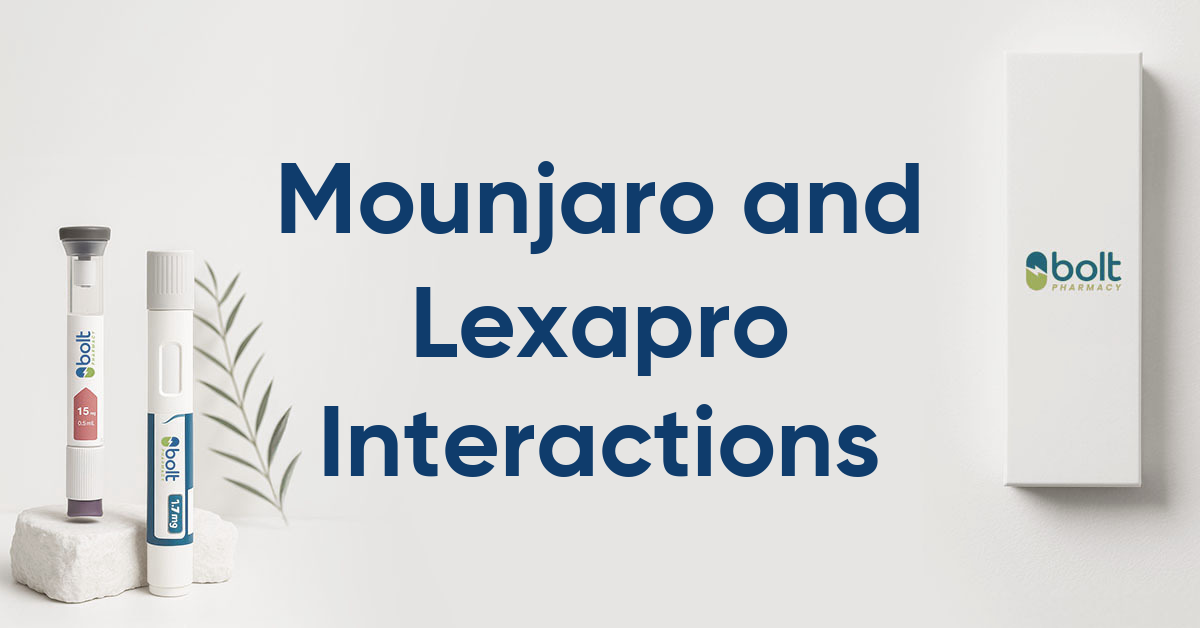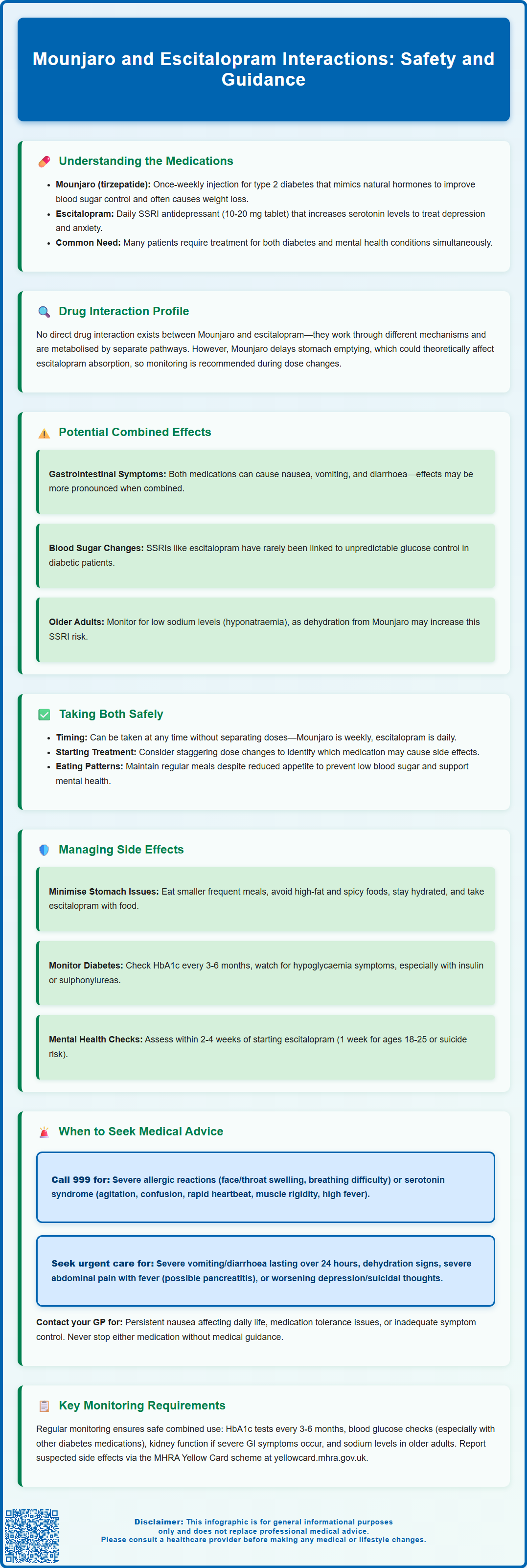Wegovy®
A weekly GLP-1 treatment proven to reduce hunger and support meaningful, long-term fat loss.
- ~16.9% average body weight loss
- Boosts metabolic & cardiovascular health
- Proven, long-established safety profile
- Weekly injection, easy to use

Many people with type 2 diabetes also experience depression or anxiety, making it common to require both Mounjaro (tirzepatide) and escitalopram (an antidepressant) simultaneously. Understanding how these medications interact is essential for safe and effective treatment. Mounjaro is a dual GIP and GLP-1 receptor agonist used to improve blood glucose control in type 2 diabetes, whilst escitalopram is a selective serotonin reuptake inhibitor (SSRI) prescribed for depression and generalised anxiety disorder. This article examines the interactions between Mounjaro and escitalopram, exploring their mechanisms, potential effects when taken together, and practical guidance for patients and healthcare professionals managing both conditions.
Summary: There is no direct pharmacological interaction between Mounjaro (tirzepatide) and escitalopram, as they work through different mechanisms and metabolic pathways.
Mounjaro (tirzepatide) is a relatively new medication licensed in the UK for the treatment of type 2 diabetes mellitus. It belongs to a class of medicines known as dual glucose-dependent insulinotropic polypeptide (GIP) and glucagon-like peptide-1 (GLP-1) receptor agonists. Mounjaro works by mimicking the action of incretin hormones, which are naturally released after eating. These hormones stimulate insulin secretion when blood glucose levels are elevated, suppress glucagon release, slow gastric emptying, and promote satiety. This multi-faceted mechanism helps improve glycaemic control and often leads to weight reduction, although weight loss is not a licensed indication in the UK. Mounjaro is administered as a once-weekly subcutaneous injection, with doses typically starting at 2.5 mg and potentially increasing to a maximum of 15 mg depending on individual response and tolerability.
Escitalopram is a selective serotonin reuptake inhibitor (SSRI) antidepressant commonly prescribed in the UK for depression and generalised anxiety disorder. In the UK, it is primarily prescribed as generic escitalopram (historically branded as Cipralex). Escitalopram works by selectively blocking the reuptake of serotonin in the brain, thereby increasing serotonin availability at synaptic junctions. This enhanced serotonergic neurotransmission helps alleviate symptoms of depression and anxiety over time. Escitalopram is typically taken as a once-daily oral tablet, with usual doses ranging from 10 mg to 20 mg daily. The medication generally requires several weeks to achieve full therapeutic effect.
Both medications are commonly prescribed in clinical practice, and it is not unusual for patients to require treatment for both type 2 diabetes and mental health conditions simultaneously. Understanding how these medications work individually provides essential context for evaluating their combined use and any potential interactions that may arise when taken together.

Currently, there is no official direct pharmacological interaction documented between tirzepatide (Mounjaro) and escitalopram in the Summary of Product Characteristics (SmPC) or major drug interaction databases. These medications work through entirely different mechanisms and are metabolised via distinct pathways. Mounjaro is a peptide-based medication that is broken down by proteolytic enzymes rather than hepatic cytochrome P450 enzymes, whilst escitalopram is primarily metabolised by the liver enzymes CYP2C19 and CYP3A4. This fundamental difference in metabolism means that neither medication is likely to significantly affect the blood levels or efficacy of the other through metabolic interference.
However, important considerations warrant attention when these medications are prescribed together. The Mounjaro SmPC notes that tirzepatide delays gastric emptying, which may affect the absorption of oral medicines. While a clinically meaningful effect on escitalopram is unlikely, patients should be monitored for any changes in antidepressant effect during tirzepatide initiation or dose titration. The SmPC specifically mentions that tirzepatide may reduce exposure to oral contraceptives, highlighting its potential to affect absorption of some oral medications.
Both Mounjaro and escitalopram can affect gastrointestinal function, though through different mechanisms. Mounjaro commonly causes nausea, vomiting, diarrhoea, and reduced appetite, particularly during dose initiation or escalation. Escitalopram may also cause gastrointestinal side effects including nausea, though typically less pronounced. When taken concurrently, patients may experience additive gastrointestinal symptoms that could affect medication adherence or nutritional intake.
Another theoretical consideration involves blood glucose regulation. Whilst escitalopram does not directly alter glucose metabolism, SSRIs have occasionally been associated with changes in glycaemic control in diabetic patients, with reports of both hypoglycaemia and hyperglycaemia in the literature. These effects appear idiosyncratic and uncommon, but clinicians should remain vigilant when initiating or adjusting either medication in patients with diabetes.
When prescribing Mounjaro and escitalopram together, healthcare professionals should adopt a holistic approach to patient care that considers the interplay between diabetes management and mental health. Depression and anxiety are significantly more prevalent in people with type 2 diabetes compared to the general population, with bidirectional relationships between these conditions. Poor glycaemic control can exacerbate mood symptoms, whilst depression may impair self-management behaviours including medication adherence, dietary choices, and physical activity.
Timing and administration of these medications can be optimised for patient convenience and tolerability. Mounjaro is administered once weekly and can be given at any time of day, with or without meals. Many patients find it helpful to establish a consistent day and time for their injection. Escitalopram is typically taken once daily, and whilst it can be taken at any time, some patients prefer morning dosing to minimise potential sleep disturbance, whilst others take it in the evening if they experience mild sedation. There is no requirement to separate the administration of these medications, though the delayed gastric emptying effect of tirzepatide is a reason to monitor clinical response rather than routinely separating doses.
Dose titration strategies should be carefully considered. When initiating Mounjaro, the standard approach involves starting at 2.5 mg weekly for four weeks before increasing to 5 mg, with further increases at four-week intervals if needed for glycaemic targets. This gradual escalation helps minimise gastrointestinal side effects. If a patient is simultaneously starting or adjusting escitalopram, clinicians might consider staggering these changes to better identify which medication may be responsible for any emerging side effects. NICE guidance (NG28 for type 2 diabetes and NG222 for depression) emphasises individualised treatment approaches that account for comorbidities and polypharmacy considerations.
Patients should be counselled about the importance of maintaining regular meal patterns despite potential appetite suppression from Mounjaro, particularly if they are taking other diabetes medications that carry hypoglycaemia risk. Adequate nutrition also supports mental health and the effectiveness of antidepressant therapy. Clinicians should consider sodium monitoring in older adults or those with symptoms suggestive of hyponatraemia after SSRI initiation, as this risk may be compounded by dehydration from gastrointestinal side effects.
Effective management of potential side effects requires proactive monitoring and patient education. The most common adverse effects of Mounjaro include nausea (occurring in up to 20% of patients), diarrhoea, vomiting, constipation, abdominal pain, and reduced appetite. These gastrointestinal symptoms are typically most pronounced during the first few weeks after starting treatment or increasing the dose, and often improve with continued use. Patients taking escitalopram concurrently should be advised that they may experience enhanced gastrointestinal symptoms initially, though these are generally manageable.
Practical strategies to minimise gastrointestinal side effects include:
Eating smaller, more frequent meals rather than large portions
Avoiding high-fat, spicy, or heavily processed foods that may exacerbate nausea
Staying well hydrated, particularly if experiencing vomiting or diarrhoea
Taking escitalopram with food if nausea occurs
Allowing adequate time between dose escalations of Mounjaro
Regular monitoring should encompass both diabetes control and mental health status. For diabetes management, this includes HbA1c measurements every 3–6 months once stable, periodic review of blood glucose monitoring results, assessment of weight changes, and monitoring for signs of diabetic complications. Patients should be educated about recognising symptoms of hypoglycaemia, particularly if taking Mounjaro alongside other glucose-lowering medications such as insulin or sulphonylureas. Renal function should be checked if significant vomiting, diarrhoea or dehydration occurs, as there is a risk of acute kidney injury.
For mental health monitoring, regular assessment of mood, anxiety symptoms, and treatment response is essential, particularly during the first few months of escitalopram therapy. In line with NICE guidance, patients should be reviewed within 2–4 weeks of starting antidepressant treatment for most adults, and within 1 week for those aged 18–25 or with suicide risk. Consider baseline and early sodium checks in older adults or those at risk of hyponatraemia after SSRI initiation. Monitor for emerging side effects, suicidal ideation (particularly in younger adults), or signs of serotonin syndrome, though the latter is rare with SSRI monotherapy.
Patients should be advised to report suspected side effects via the MHRA Yellow Card scheme (yellowcard.mhra.gov.uk or via the Yellow Card app).
Patients taking both Mounjaro and escitalopram should be clearly informed about specific circumstances that warrant prompt medical attention. Understanding these warning signs empowers patients to seek help appropriately whilst avoiding unnecessary anxiety about minor, self-limiting symptoms.
Urgent medical review is required if patients experience:
Severe or persistent vomiting or diarrhoea lasting more than 24 hours, which may lead to dehydration and electrolyte disturbances
Signs of dehydration including dizziness, reduced urine output, extreme thirst, or confusion
Severe abdominal pain, particularly if accompanied by fever or persistent vomiting, which could indicate pancreatitis (a rare but serious side effect of GLP-1 receptor agonists) – if pancreatitis is suspected, stop tirzepatide immediately and seek urgent medical attention
Symptoms of hypoglycaemia such as trembling, sweating, confusion, or palpitations, especially if taking other diabetes medications
Allergic reactions including rash, swelling of the face or throat, or difficulty breathing – call 999 or attend A&E for severe allergic reactions or severe breathing difficulties
Worsening depression, emergence of suicidal thoughts, or significant changes in mood or behaviour
Signs of serotonin syndrome (though rare) including agitation, confusion, rapid heart rate, high blood pressure, dilated pupils, muscle rigidity, or high fever
Patients should contact their GP or diabetes team for routine concerns such as persistent nausea affecting quality of life, difficulty tolerating medication, questions about dose adjustments, or if they are not achieving adequate symptom control for either their diabetes or mental health condition. For urgent advice when their GP is unavailable, patients can contact NHS 111. It is important that patients do not discontinue either medication without medical guidance, as abrupt cessation of escitalopram can lead to discontinuation symptoms, and stopping Mounjaro may result in deterioration of glycaemic control.
Regular scheduled reviews with healthcare professionals remain essential for optimising treatment outcomes and ensuring both conditions are adequately managed in an integrated manner.
Yes, there is no direct pharmacological interaction between Mounjaro (tirzepatide) and escitalopram. They work through different mechanisms and are metabolised via distinct pathways, making them generally safe to take together under medical supervision.
Both medications can cause gastrointestinal side effects such as nausea, which may be more pronounced when taken together. Monitor for severe vomiting, dehydration, worsening mood, or signs of hypoglycaemia, and contact your healthcare provider if these occur.
Mounjaro delays gastric emptying, which could theoretically affect absorption of oral medications like escitalopram, though clinically significant effects are unlikely. Your healthcare provider should monitor your antidepressant response, particularly when starting or adjusting Mounjaro doses.
The health-related content published on this site is based on credible scientific sources and is periodically reviewed to ensure accuracy and relevance. Although we aim to reflect the most current medical knowledge, the material is meant for general education and awareness only.
The information on this site is not a substitute for professional medical advice. For any health concerns, please speak with a qualified medical professional. By using this information, you acknowledge responsibility for any decisions made and understand we are not liable for any consequences that may result.
Lorem ipsum dolor sit amet, consectetur adipiscing elit, sed do eiusmod tempor incididunt ut labore et dolore magna aliqua. Ut enim ad minim veniam, quis nostrud exercitation ullamco laboris nisi ut aliquip ex ea commodo consequat. Duis aute irure dolor in reprehenderit in voluptate velit esse cillum dolore eu fugiat nulla pariatur.
Block quote
Ordered list
Unordered list
Bold text
Emphasis
Superscript
Subscript